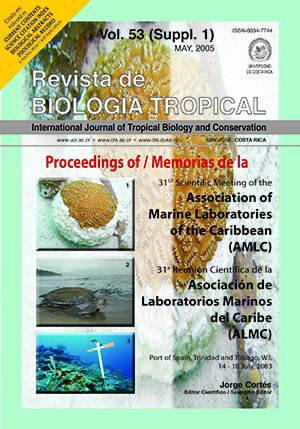Abstract
Grande Riviere Beach in Trinidad and Tobago is an important nesting site in the Caribbean for the Critically Endangered leatherback sea turtle, Dermochelys coriacea. Community members were concerned that beach erosion and seasonal river flooding were destroying many of the nests deposited annually and thought that a hatchery was a possible solution. Over the 2001 turtle nesting season, the Institute of Marine Affairs (IMA) assessed the spatial and temporal distribution of nests using the Global Positioning System recorded to reference points, and beach dynamics using permanent bench mark profile stations, to determine areas of high risk and more stable areas for nesting. A total of 1449 leatherback nests were positioned. It was evident that at the start of the season in March, the majority of leatherback nests were deposited at the eastern section of the beach. After May, there was a continuing westward shift in nest distribution as the season progressed until August and beach erosion in the eastern section became predominant. The backshore remained relatively stable along the entire beach throughout the nesting season, and erosion was predominant in the foreshore at the eastern section of the beach, from the middle to the end of the season. Similar trends in accretion and erosion were observed in 2000. River flooding did not occur during the study period or in the previous year. With both high risk and more stable regions for turtle nesting available at Grande Riviere Beach, there was no compelling evidence to justify the need for a hatchery.References
Boulon, R.H. Jr., P.H. Dutton & D.L. McDonald. 1996. Leatherback turtles, Dermochelys coriacea, on St. Croix, U.S. Virgin Islands: fifteen years of conservation. Chelon. Conserv. Biol. 2: 141-147.
Chu Cheong, L. 1990. Observations on the nesting population of leatherback turtles Dermochelys coriacea, in Trinidad. Carib. Mar. Stud. 1: 48-53.
Fournillier, K. and K.L. Eckert. 1998. WIDECAST Sea Turtle Recovery Action Plan for Trinidad and Tobago. CEP Technical Report. United Nations Environment Programme, Kingston, Jamaica.
Girondot, M. & J. Fretey. 1996. Leatherback turtles, Dermochelys coriacea, nesting in French Guiana, 1978-1995. Chelon. Conserv. Biol. 2: 204-208.
Godley, B., A. Broderick, S. Blackwood, L. Collins, K. Glover, C. McAldowie, D. McCulloch & J. McLeod. 1993. 1991 Survey of marine turtles nesting in Trinidad and Tobago. Marine Turtle Newsletter 61: 15-18.
King, C.A. 1972. Beaches and Coasts. Edward Arnold (Publishers) Ltd., London. 570 p.
Leslie, A., D. Penick, J. Spotila & F. Paladino. 1996. Leatherback turtle, Dermochelys coriacea, nesting and nest success at Tortuguero, Costa Rica, in 1990- 1991. Chelon. Conserv. Biol. 2: 159-168.
Witherington, B.E. 1999. Reducing threats to nesting habitat, pp. 179-183. In K. Eckert, K. Bjorndal, F. Abreu-Grobois & M. Donnelly (eds.) Research and Management Techniques for the Conservation of Sea Turtles. IUCN/SSC Marine Turtle Specialist Group Publication No. 4. Pennsylvania, USA.

This work is licensed under a Creative Commons Attribution 4.0 International License.
Copyright (c) 2005 Revista de Biología Tropical

